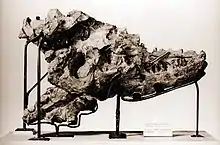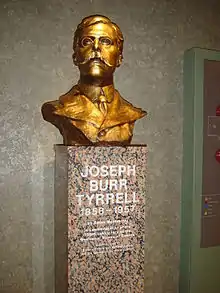Joseph Tyrrell
Joseph Burr Tyrrell, FRSC (November 1, 1858 – August 26, 1957) was a Canadian geologist, cartographer and mining consultant. He discovered dinosaur (Albertosaurus sarcophagus) bones in Alberta's Badlands and coal around Drumheller in 1884. Canada's Royal Tyrrell Museum of Palaeontology in Alberta was named in his honour.
Joseph Tyrrell | |
|---|---|
 | |
| Born | Joseph Burr Tyrrell November 1, 1858 |
| Died | August 26, 1957 (aged 98) Toronto, Ontario, Canada |
| Alma mater | Upper Canada College University of Toronto |
| Known for | discovery of Albertosaurus in Alberta, c. 1884 |
| Scientific career | |
| Fields | geology, cartography |

Tyrrell was born in Weston, Ontario, the third child of William and Elizabeth Tyrrell. He was a student at Weston Grammar School before graduating from Upper Canada College in 1876 and receiving a law degree from the University of Toronto in 1880. After articling for a law firm in Toronto, his doctor advised him to work outdoors due to his health.
He joined the Geological Survey of Canada in 1880,[1] leading or participating in numerous explorations. He led the 1893 and 1894 expeditions into the Northern Barren Lands, down the Dubawnt River, the first visit to the Kivalliq Region Barrenlands by a European since the explorations of Samuel Hearne in the 1770s. His younger brother, James Williams Tyrrell, accompanied Tyrrell on the expedition, which included the first European contact with the Ihalmiut, an Inuit people from the interior of what is today Nunavut.
Tyrrell married Mary Edith Carey in 1894 and they had three children, Mary (1896), George (1900), and Thomas (1906).[2] Mary Edith was founder and first president in 1921 of the Women's Association of the Mining Industry of Canada.[3] In 1894, Tyrrell stumbled upon biographical recollections (11 books of field notes, 39 journals, maps and a narrative) of Canadian overland explorer, cartographer and fur trader David Thompson and, in 1916, published them as David Thompson's Narrative.[4]
Tyrrell went into the gold-mining business in 1898, a career that would last more than 50 years.
He was mine manager of the Kirkland Lake Gold Mine in northern Ontario for many years starting in 1926.[1]:191[5]
Tyrrell retired to northeast Scarborough on the Rouge River, where he established substantial apple orchards and interest in grafting and breeding. The expanded orchards, later managed by his son George, are now the site of the Toronto Zoo. He died in Toronto in 1957 at the age of 98.
Honours and awards

Places named for Tyrrell
- Tyrrell Sea (prehistoric Hudson Bay)
- Tyrrell Arm, the east section of Yathkyed Lake, Nunavut[6]
- Joseph Burr Tyrrell Park, Toronto, Ontario
- Tyrrell Lake, a small alkali lake near Warner, Alberta.
Institutions named for Tyrrell
- Royal Tyrrell Museum of Palaeontology, Drumheller, Alberta
- J. B. Tyrrell Senior Public School in Scarborough, Ontario
- Joseph Burr Tyrrell Elementary School in Fort Smith, Northwest Territories
Awards
- 1896 Back Award, Royal Geographical Society
- 1918 Murchison Medal, Geological Society of London
- 1929 Honorary President, Royal Canadian Geographical Society
- 1930 Daly Medal from the American Geographical Society
- 1933 Flavelle Medal, Royal Society of Canada
- 1947 Wollaston Medal, Geological Society of London
- 1954 Professional Engineer's Medal from the Association of Professional Engineers of Ontario
- 1997 Canadian Mining Hall of Fame
Other honours
- J.B. Tyrrell Historical Medal, Royal Society of Canada.
Tribute
On 1 November 2018, Google Doodle commemorated his 160th birthday.[7]
References
- Barnes, Michael (1986). Fortunes in the Ground. Erin, Ontario: The Boston Mills Press. p. 170,198–199. ISBN 091978352X.
- "Joseph Burr Tyrrell". everything2.com. Retrieved 2008-01-27.
- "Hall of Fame Inductee". mining.ca. Archived from the original on 2007-12-14. Retrieved 2008-01-27.
- "A short history". Archived from the original on 2008-01-23. Retrieved 2008-01-27.
- Pain, S.A. (1960). Three Miles of Gold: The Story of Kirkland Lake. Toronto: The Ryerson Press. p. 53.
- "Kazan River". chrs.ca. Archived from the original on 2007-11-10. Retrieved 2007-12-25.
- "Joseph Burr Tyrrell's 160th Birthday". Google.com. 1 November 2018.
Further reading
- "Biographical Sketch of J.B. Tyrrell - University of Toronto". Retrieved 16 September 2007.
- "Past lives: Chronicles of Canadian Paleontology Tyrrell and Albertosaurus". Archived from the original on 10 January 2006. Retrieved 2 January 2006.
- Historica minute
- "Joseph B. Tyrrell - Hall of Fame - Life of a Rock Star". Retrieved 2 January 2006.
- A biography by Heather Robertson, 2007, Measuring Mother Earth: How Joe the Kid became Tyrrell of the North, McClelland & Stewart Inc. ISBN 0-7710-7539-1
External links
| Wikimedia Commons has media related to Joseph Tyrrell. |
- The Barren Lands Collection at the Thomas Fisher Rare Book Library, University of Toronto
- Royal Tyrrell Museum website
- Scientist of the Day-Joseph Burr Tyrrell at Linda Hall Library
- Works by Joseph Burr Tyrrell at Faded Page (Canada)
- The History of the Geological Survey of Canada in 175 Objects
- Joseph Burr Tyrrell at The Canadian Encyclopedia
- Historica’s Heritage Minute video docudrama about Joseph Tyrrell. (Adobe Flash Player.)
- Joseph Burr Tyrrell Papers, Thomas Fisher Rare Book Library
- L’histoire de la Commission géologique du Canada illustrée par 175 objets
